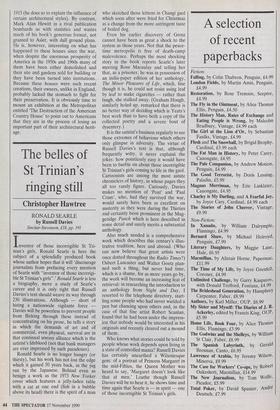The belles of St Trinian's ringing still
Christopher Hawtree
RONALD SEARLE by Russell Davies Sinclair-Stevenson, £18, pp. 191 Inventor of those incorrigible St Tri- nian's girls, Ronald Searle is here the subject of a splendidly produced book whose author hopes that it will 'discourage journalists from prefacing every mention of Searle with "inventor of those incorrigi- ble St Trinian's girls".' Ronald Searle is less a biography, more a study of Searle's career and it is only right that Russell Davies's text should weave its way through 230 illustrations. Although — short of hiring a nationwide vigilante force Davies will be powerless to prevent people from flicking through these instead of concentrating on his prose, he tells a story in which the demands of art and of commercial, even physical, survival are in that continual uneasy alliance which is the satirist's lifeblood (not that bank managers are ever impressed by such paradoxes).
Ronald Searle is no longer hungry (or thirsty), but his work has not lost the edge which it gained 50 years back, in the jug run by the Japanese. Behind even as benign a work as the 1973 New Yorker cover which features a jelly-laden table with a cat at one end (fish in a bubble above its head) there is the spirit of a man who sketched those kittens in Changi gaol which soon after were fried for Christmas as a change from the more astringent taste of boiled dog.
Even his earlier discovery of Grosz cannot have been as great a shock to the system as those years. Not that the peace- time metropolis is free of death-camp malevolence. Perhaps the most shocking story in the book reports Searle's later meeting Rose Macaulay and telling her that, as a prisoner, he was in possession of an india-paper edition of her anthology, The Minor Pleasures of Life, which, fine though it is, he could not resist using leaf by leaf to make cigarettes — rather than laugh, she stalked away. (Graham Hough, similarly holed up, remarked that there is no better way of deciding which is Yeats's best work than to have both a copy of the collected poetry and a severe bout of dysentery.) It is the satirist's business regularly to see those extremes of behaviour which others only glimpse in adversity. The virtue of Russell Davies's text is that, although frequently witty, it never explains the jokes: how pointlessly easy it would have been to burble on about those incorrigible St Trinian's girls coming to life in the gaol. Cartoonists are among the most astute chroniclers of history, in whose pages they all too rarely figure. Curiously, Davies makes no mention of 'Pont' and 'Paul Crum', who, had they survived the war, would surely have been as excellent on austerity as they were during the Thirties and certainly been prominent in the Mug- geridge Punch which is here described in some detail and surely merits a substantial anthology.
Also much needed is a comprehensive work which describes this century's illus- trative tradition, here and abroad. (Who can now believe that great artists were once dotted throughout the Radio Times?) Osbert Lancaster and Walter Goetz plan- ned such a thing, but never had time, which is a shame, for as more years go by, the work will become an increasing feat of retrieval: in researching the introduction to an anthology from Night and Day, I resorted to the telephone directory, start- ling some people who had never wielded a pen but chancing upon others and, in the case of that fine artist Robert Scanlan, found that he had been under the impress- ion that nobody would be interested in his originals and recently cleared out a mound of them.
Who knows what stories could be told by people whose work depends upon living in a state of controlled mania? Russell Davies has certainly unearthed a Wilsonesque gem: of a portrait of Princess Margaret in the mid-Fifties, the Queen Mother was heard to say, 'Margaret doesn't look like that at men.' Loathe though Russell Davies will be to hear it, he shows time and time again that Searle is — in spirit — one of those incorrigible St Trinian's girls.























































 Previous page
Previous page